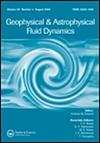行星和恒星中稳定分层区域的磁流体动力学
IF 1.1
4区 地球科学
Q3 ASTRONOMY & ASTROPHYSICS
Geophysical and Astrophysical Fluid Dynamics
Pub Date : 2019-10-09
DOI:10.1080/03091929.2019.1670827
引用次数: 6
摘要
稳定分层层存在于恒星内部(辐射区)和行星内部——最近对地球磁场的观测和理论研究似乎表明,在液态外核的顶部存在一层薄而稳定的分层层。我们提出了该区域的直接数值模拟,它被模拟为一个轴对称的球形库埃特流的稳定分层流体嵌入在一个偶极磁场。在强磁场作用下,稳定分层区产生超旋转剪切层,其旋转速度比内对流发电机区与外边界之间施加的旋转速度差快近30%。在地球的背景下,与之前所认为的相反,我们表明,如果密度分层足够大,这种超旋转可能会向地球磁转状态延伸。相应的微分旋转触发了层状区域的磁流体动力学不稳定性和波动,其特征是增长率与观测到的地磁长期变化和跳变的时间尺度相当。在恒星的背景下,我们进行了线性分析,表明可能会出现类似的不稳定性,我们认为它可能在解释中质量恒星中观测到的磁二分法中起作用。本文章由计算机程序翻译,如有差异,请以英文原文为准。
Magnetohydrodynamics of stably stratified regions in planets and stars
ABSTRACT Stably stratified layers are present in stellar interiors (radiative zones) as well as planetary interiors – recent observations and theoretical studies of the Earth's magnetic field seem to indicate the presence of a thin, stably stratified layer at the top of the liquid outer core. We present direct numerical simulations of this region, which is modelled as an axisymmetric spherical Couette flow for a stably stratified fluid embedded in a dipolar magnetic field. For strong magnetic fields, a super-rotating shear layer, rotating nearly 30% faster than the imposed rotation rate difference between the inner convective dynamo region and the outer boundary, is generated in the stably stratified region. In the Earth context, and contrary to what was previously believed, we show that this super-rotation may extend towards the Earth magnetostrophic regime if the density stratification is sufficiently large. The corresponding differential rotation triggers magnetohydrodynamic instabilities and waves in the stratified region, which feature growth rates comparable to the observed timescale for geomagnetic secular variations and jerks. In the stellar context, we perform a linear analysis which shows that similar instabilities are likely to arise, and we argue that it may play a role in explaining the observed magnetic dichotomy among intermediate-mass stars.
求助全文
通过发布文献求助,成功后即可免费获取论文全文。
去求助
来源期刊

Geophysical and Astrophysical Fluid Dynamics
地学天文-地球化学与地球物理
CiteScore
3.10
自引率
0.00%
发文量
14
审稿时长
>12 weeks
期刊介绍:
Geophysical and Astrophysical Fluid Dynamics exists for the publication of original research papers and short communications, occasional survey articles and conference reports on the fluid mechanics of the earth and planets, including oceans, atmospheres and interiors, and the fluid mechanics of the sun, stars and other astrophysical objects.
In addition, their magnetohydrodynamic behaviours are investigated. Experimental, theoretical and numerical studies of rotating, stratified and convecting fluids of general interest to geophysicists and astrophysicists appear. Properly interpreted observational results are also published.
 求助内容:
求助内容: 应助结果提醒方式:
应助结果提醒方式:


